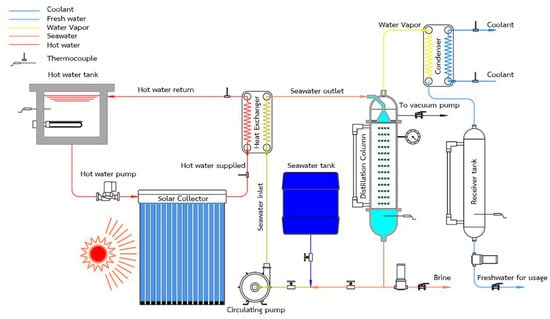- Article
Development and Performance of a Vacuum-Based Seawater Desalination System Driven by a Solar Water Heater
- Wichean Singmai,
- Pichet Janpla and
- Suparat Jamsawang
- + 2 authors
This work proposes the design, construction, and field test of a vacuum seawater desalination system (VSDS) driven by an evacuated tube solar collector (with a total absorption area of 1.86 m2) under tropical climatic condition (Thailand ambient at latitude 13°43′06.0″ N, longitude 100°32′25.4″ E). The VSDS prototype was designed and constructed to be driven by hot water, which is produced by two heat source conditions: (1) an electric heater for laboratory tests and (2) an evacuated tube solar collector for field tests under real climatic conditions. A comparative experimental study to assess the ability to produce fresh water between a conventional dripping/pipe feed column and spray falling film column is proposed in the first part of the discussion. This is to demonstrate the advantage of the spray falling film distillation column. The experimental method is implemented based on the batch system, in which the cycle time (distillation time) considered is 10–20 min so that heat loss via the concentrated seawater blow down is minimized. Later, the field test with solar irradiance under real climatic conditions is demonstrated to assess the freshwater yield and the system performance. The aim is to provide evidence of the proposed vacuum desalination system in real operation. It is found experimentally that the VSDS working with spray falling film provides better performance than the dripping/pipe feed column under the specified working conditions. The spray falling film column can increase the distillated freshwater volume from 1.33 to 2.16 L under identical cycle time and working conditions. The improvement potential is up to 62.4%. The overall thermal efficiency can be increased from 33.7 to 70.8% (improvement of 110.1%). Therefore, the VSDS working with spray falling film is selected for implementing field tests based on real solar irradiance powered by an evacuated tube solar collector. The ability to produce fresh water is assessed, and the overall performance via the average distillation rate and the thermal efficiency (or Gain Output Ratio) is discussed with the real solar irradiance. It is found from the field test with solar time (8.00–16.00) that the VSDS can produce a daily freshwater yield of up to 4.5 L with a thermal efficiency of up to 19%. The freshwater production meets the requirement for international standard drinking water criteria, indicating suitability for household/community use in tropical regions. This work demonstrates the feasibility of VSDS working under real solar irradiance as an alternative technology for sustainable fresh water.
26 December 2025


